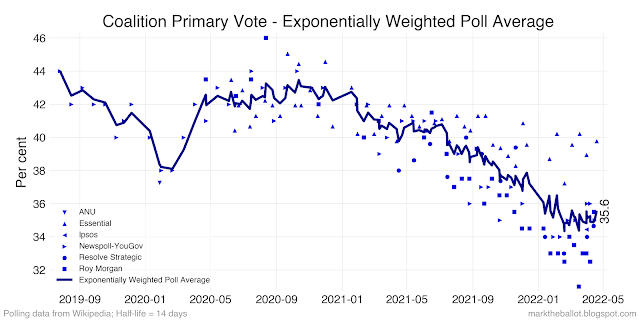The election was called on 10 April, just over a fortnight ago. According to Wikipedia, there have been four national polls in that time. While the paucity of polling in Australia is a problem, there are some interesting trends.
First, so far we have not seen the extreme herding that occurred among pollsters in the lead up to the 2019 election. My calculation of the 2pp polls since the election was called range between Labor ahead with 51.0 per cent and 53.4 per cent (using preference flows from the 2019 election). Labor is more likely to highly likely to win the 2022 election, provided the actual 2pp at the election is in this range. My current working estimate is that Labor should win around 80 seats (of 151 seats), but I will firm this estimate up closer to the election.
Second, we have seen a substantial tightening in the race. Two-party preferred (2pp) opinion polls for the Coalition have improved more than a percentage point, from their nadir earlier in 2022.
This is not just something we are seeing in aggregate terms. It is also evident in the trends from each of the individual pollsters. I should note that in the next few charts, the exponentially weighted approach will be slower to recognise changes than the LOWESS regression. On the other hand, the LOWESS regression can be over-influenced by the final data points in a series, and at the end it can suggest a larger changes than has actually occurred.
The betting markets also suggest the race might be tighter than even the polls foreshadow. At 10.30am on ANZAC day, Labor was on \$1.70 to win. The Coalition was on \$2.10.
Third, the pollsters are all over the shop floor when it comes to the primary vote share for the non-mainstream parties (ie. the other party vote excluding the Coalition, Labor and the Greens). We have estimates ranging between 8.4 per cent and 16.8 per cent.
The divergence between pollsters on the other-party vote share could be significant when it comes to 2022 election. The other party primary vote has been growing in recent elections. If the trend continues, it means that Labor or the Coalition could form government with a record low primary vote. The old rules-of-thumb for the minimum primary vote necessary for majority government may not apply in this election.
However, the divergence between pollsters makes it hard to discern whether there is a trend in other party voting. Depending on the aggregation approach I apply, I get three different stories: (a) voting intention is at a record high 16.6 per cent; (b) it is down a couple of percentage points from a recent high, at 13.5 per cent; and (c) it is well down on the recent high at 12.9 per cent. This will be something to watch closely over the next four weeks between now and the election.
Nonetheless, there is speculation that some high profile seats may fall to other party candidates at the coming election. The betting markets have independents ahead (or a close second, under $3) in the following seats: Mackeller (NSW), North Sydney (NSW), Warringah (NSW), Wentworth (NSW), Goldstein (Vic), Indi (Vic), Kooyong (Vic), Nicholls (Vic), Curtin (WA), and Clark (Tas). Also, minor parties are well placed to keep Kennedy (Qld), Melbourne (Vic), and Mayo (SA). It is more likely than not that the total number of Greens, other minor parties and independent seats will grow following the 2022 election.
Fourth, the Greens primary vote polling is up a little, but largely unchanged since the 2019 election.
Fifth, the Coalition has seen a small increase in its primary vote, and Labor has seen a slightly larger decrease. In respect of the LOWESS and exponentially weighted charts, please note the caveats from above:
Finally, there is always the nagging doubt that the polls could be wrong again (as they were in 2019). Federally, there is a long history of the opinion polls being slightly more favourable to Labor (on average, but not at every election) when compared with the final vote count. However, it should be noted that there are new entrants to the polling market, and some long-term players have left the market. Most pollsters have changed their methodology following the 2019 polling failure. Hence, there is a possibility that the pollsters have over corrected their methodologies following 2019, and today's polls are actually leaning to the Coalition.
If you have read this far, well done. You might be interested in Buckley's and None, which uses a statistical model to predict the number of seats each party should win. [Disclaimer. I have no relationship with Buckley's and None, but I like the approach they took to seat estimation].
Update: I also like the model at Armarium Interreta. [Disclaimer, I have no relationship with the authors of this model.





















No comments:
Post a Comment